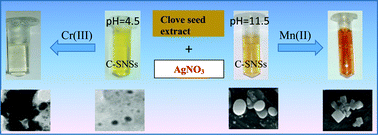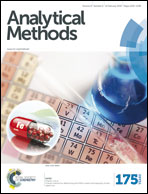pH-controlled sensitive and selective detection of Cr(iii) and Mn(ii) by using clove (S. aromaticum) reduced and stabilized silver nanospheres†
Abstract
The colorimetric detection of toxic metal ions based on silver nanoparticles (AgNPs) has received significant attention due to their distance dependent optical properties. Our study reports a new, green, selective and sensitive colorimetric detection method for Cr(III) and Mn(II) by using clove silver nanospheres (C-SNSs) synthesized at two different pH values 4.5 and 11.5. At pH 4.5, C-SNSs gradually aggregated in the presence of Cr(III) ions and showed a color change from light yellow to colorless. At pH 11.5, they showed rapid aggregation, not only with a colorimetric change from dark yellow to reddish brown, but also with an alteration in the morphology of spheres to square pyramidal in the presence of Mn(II) ions. Cr(III) and Mn(II) ions were detected using colorimetry and spectrometry. Under optimized conditions, our method showed better selectivity for Cr(III) and Mn(II) ions as compared to other metal ions. The lowest limit of detection (LOD) of C-SNSs was 0.20 μM for both Cr(III) and Mn(II), which is significantly lower than the Environmental Protection Agency (EPA) permissible limits of 1.92 μM for Cr(III) and 0.91 μM for Mn(II).



 Please wait while we load your content...
Please wait while we load your content...